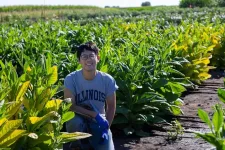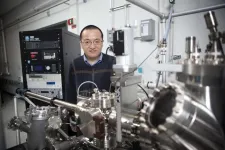(Press-News.org) DURHAM, N.C. – If you have a deep-seated, nagging worry over dropping your phone in molten lava, you’re in luck.
A research team led by materials scientists at Duke University has developed a method for rapidly discovering a new class of materials with heat and electronic tolerances so rugged that they that could enable devices to function at lava-like temperatures above several thousands of degrees Fahrenheit.
Harder than steel and stable in chemically corrosive environments, these materials could also form the basis of new wear- and corrosion-resistant coatings, thermoelectrics, batteries, catalysts and radiation-resistant devices.
The recipes for these materials — ceramics made using transition metals carbonitrides or borides — were discovered through a new computational method called Disordered Enthalpy-Entropy Descriptor (DEED). In its first demonstration, the program predicted the synthesizability of 900 new formulations of high-performance materials, 17 of which were then tested and successfully produced in laboratories.
The results appear online January 3 in the journal Nature and include contributions from collaborators at Penn State University, Missouri University of Science and Technology, North Carolina State University, and State University of New York at Buffalo.
“The capability of rapidly discovering synthesizable compositions will allow researchers to focus on optimizing their industry-disrupting properties,” said Stefano Curtarolo, the Edmund T. Pratt Jr. School Distinguished Professor of Mechanical Engineering and Materials Science at Duke.
The Curtarolo group maintains the Duke Automatic-FLOW for Materials Database (AFLOW)—an enormous reservoir of material properties data connected to many online tools for materials optimization. This wealth of information allows algorithms to accurately predict the properties of unexplored mixtures without having to attempt to simulate the complexities of atomic dynamics or make them in the laboratory.
For the past several years, the Curtarolo group has been working to develop predictive powers for “high-entropy” materials that derive enhanced stability from a chaotic mixture of atoms rather than relying solely on the orderly atomic structure of conventional materials. In 2018, they discovered high-entropy carbides, which were a simpler, special-case scenario.
“The high-entropy carbides all had a relatively uniform amount of enthalpy, so we could ignore part of the equation,” Curtarolo said. “But to predict new ceramic recipes with other transition metals, we had to address the enthalpy.”
To better understand the concepts of entropy and enthalpy in this application, think of a 10-year-old trying to construct a doghouse out of a giant pile of Legos. Even with limited types of building blocks, there would be many possible design outcomes.
In simple terms, enthalpy is a measure of how sturdy each design is, and entropy a measure of the number of possible designs that all have similar strength. The first promotes ordered configurations, like those that might be found in instruction booklets. The latter captures the unavoidable chaos that would occur as the child puts more time and energy into the increasingly confusing construction effort. Both are a measure of the amount of energy and heat that end up being absorbed into the final product.
“To rapidly quantify both enthalpy and entropy, we had to calculate the energy contained within the hundreds of thousands of various combinations of ingredients that we could potentially create instead of the ceramics we’re looking for,” Curtarolo said. “It was a mammoth undertaking.”
Besides predicting new recipes for stable disordered ceramics, DEED also helps direct their further analysis to discover their inherent properties. To find the optimal ceramics for various applications, researchers will need to refine these calculations and physically test them in laboratories.
DEED is specifically tailored to a production method called hot-pressed sintering. This involves taking powdered forms of the constituent compounds and heating them in a vacuum to as high as 4000 degrees Fahrenheit while applying pressure for times that can be as long as a few hours. Between all the preparation, reaction and cooling times, the entire process takes more than eight hours.
“The final step in synthesis, called spark plasma sintering, is an emerging method in materials science that is common in research labs,” said William Fahrenholtz, the Curators’ Distinguished Professor of Ceramic Engineering at Missouri S&T.
The finished ceramics have a metallic appearance and look dark grey or black. They feel like metal alloys such as stainless steel and have a similar density, but they are much darker in appearance. And even though they appear metallic, they are hard and brittle like conventional ceramics.
Moving forward, the group expects other researchers to begin using DEED to synthesize and test the properties of new ceramic materials for various applications. Given the incredible array of potential properties and uses, they believe it’s only a matter of time before some of them enter commercial production.
“Spark plasma sintering or field assisted sintering technology (FAST) is not a common technique in industry yet,” added Doug Wolfe, professor of materials science and engineering and associate vice president for research at Penn State. “However, current ceramic manufacturers could pivot to making these materials by making small adjustments to existing processes and facilities.”
This research was primarily supported by a five-year, $7.5 million grant through the US Department of Defense’s Multidisciplinary University Research Initiative (MURI) competition led by Curtarolo (N00014-21-1-2515, N00014-23-1-2615) and the Department of Defense High Performance Computing Modernization Program (HPC-Frontier).
CITATION: “Disordered Enthalpy-Entropy Descriptor for High-Entropy Ceramics Discovery,” Simon Divilov, Hagen Eckert, David Hicks, Corey Oses, Cormac Toher, Rico Friedrich, Marco Esters, Michael J. Mehl, Adam C. Zettel, Yoav Lederer, Eva Zurek, Jon-Paul Maria, Donald W. Brenner, Xiomara Campilongo, Suzana Filipović, William G. Fahrenholtz, Caillin J. Ryan, Christopher M. DeSalle, Ryan J. Crealese, Douglas E. Wolfe, Arrigo Calzolari and Stefano Curtarolo. Nature, Jan. 3, 2024`. DOI: 10.1038/s41586-023-06786-y
# # #
END
Computational method discovers hundreds of new ceramics for extreme environments
A new computational method unveils hundreds of new ceramic materials with a wide range of potentially industry-disrupting properties like electronics that could function in a lava bath
2024-01-03
ELSE PRESS RELEASES FROM THIS DATE:
Community cancer care linked with poorer outcomes for patients with a common head and neck cancer
2024-01-03
FOR IMMEDIATE RELEASE
Care for patients with human papillomavirus (HPV)-related squamous cell cancers of the oropharynx (an area in back of the throat) is shifting toward community cancer centers, but patients treated in this setting may be less likely to survive, according to new research by investigators from the Johns Hopkins Kimmel Cancer Center and its Head and Neck Cancer Center.
The study, published Jan. 3 in the Journal of the National Cancer Institute, raises concerns about the quality of care that patients with this type of head and neck cancer receive outside of academic medical centers. Patients treated ...
Beta blocker used to treat heart problems and other medical concerns could be new treatment for sickle cell cardiomyopathy
2024-01-03
INDIANAPOLIS—A beta blocker typically used to treat heart problems, hemangioma, migraines and anxiety could be a new therapeutic for patients with sickle cell disease. Researchers led by Ankit A. Desai, MD, associate professor of medicine at the Krannert Cardiovascular Research Center (KCVRC) at Indiana University School of Medicine, have been awarded a $3 million grant by the U.S. Department of Defense to evaluate the efficacy of this drug.
Patients with sickle cell disease, a red blood ...
Cleveland Clinic and University of Western Ontario awarded $4.9 million from the Helmsley Charitable Trust to build Crohn’s disease and ileostomy research consortium
2024-01-03
Cleveland Clinic and the University of Western Ontario have been awarded a $4.9 million grant from Helmsley Charitable Trust to build a consortium to develop clinical trial outcome tools for patients with Crohn's disease and permanent ileostomy.
A permanent ileostomy is a surgical procedure to divert stool from the intestine after removing part of or the whole colon. The new Endpoint Development for Ostomy Clinical Trial (EndO-trial) Consortium seeks to develop more effective drugs for patients with Crohn's disease who have undergone ...
Researchers improve seed nitrogen content by reducing plant chlorophyll levels
2024-01-03
Chlorophyll plays a pivotal role in photosynthesis, which is why plants have evolved to have high chlorophyll levels in their leaves. However, making this pigment is expensive because plants invest a significant portion of the available nitrogen in both chlorophyll and the special proteins that bind it. As a result, nitrogen is unavailable for other processes. In a new study, researchers reduced the chlorophyll levels in leaves to see if the plant would invest the nitrogen saved into other process that might improve nutritional quality.
Over the past few decades, researchers ...
How does corrosion happen? New research examines process on atomic level
2024-01-03
BINGHAMTON, N.Y. -- When water vapor meets metal, the resulting corrosion can lead to mechanical problems that harm a machine’s performance. Through a process called passivation, it also can form a thin inert layer that acts as a barrier against further deterioration.
Either way, the exact chemical reaction is not well understood on an atomic level, but that is changing thanks to a technique called environmental transmission electron microscopy (TEM), which allows researchers to directly view molecules interacting ...
Survival of the fittest: Words like 'Sex' and 'fight' are most likely to stand the test of time
2024-01-03
New research from the University of Warwick reveals that words like 'sex' endure in our language in a ‘survival of the fittest’ way, similar to natural selection.
Whilst the recent announcement of Word of the Year explores new words, like ‘rizz’ or ‘situationship’, Professor Thomas Hills’ research delves into why some words survive in our modern linguistic landscape, while others don’t.
The study concludes that words with the strongest lasting power are:
Words acquired earlier in life
Words associated with things people can see ...
NYU Grossman School of Medicine and Sarah Lawrence College launch graduate genomics degree program
2024-01-03
NYU Grossman School of Medicine’s Vilcek Institute of Graduate Biomedical Sciences and Sarah Lawrence College today announced the launch of a master’s program in genome health analysis (GHA).
Building on the strengths of both institutions, the new program will focus on analyses of patient genomes, the complete sets of genetic information in human cells. New tools have dramatically increased the amount and quality of genomic data available on each patient, but the field is constrained by the small number of experts trained to use and apply ...
Older adults with newly diagnosed migraine disorder three times more likely to have motor vehicle crash
2024-01-03
A new study from researchers at the University of Colorado Anschutz Medical Campus finds that older adult drivers who are recently diagnosed with migraines are three times as likely to experience a motor vehicle crash. Older adult drivers who reported having ever had migraines in the past were no more likely to have a motor vehicle crash than those without migraines.
Additionally, study results, published in the Journal of the American Geriatrics Society, explored the relationships medications commonly prescribed for migraine management have with increased crash risk.
“Migraine headaches affect ...
Researchers identify circulating proteins linked to preeclampsia and other hypertensive disorders of pregnancy
2024-01-03
BOSTON – Preeclampsia and other hypertensive disorders of pregnancy—which are characterized by high blood pressure with or without organ dysfunction during the second half of pregnancy—carry considerable short- and long-term risks for both the mother and child. Treatment options (other than expedited delivery) remain limited.
A team led by researchers at Massachusetts General Hospital (MGH) and the Broad Institute recently identified several proteins with strong evidence of causal or protective roles for hypertensive disorders of pregnancy, which could provide clues into how the conditions arise and how they might be prevented or treated.
In the study, which ...
New study taps artificial intelligence to streamline the crowdsourcing of ideas
2024-01-03
INFORMS Journal Marketing Science Study Key Takeaways:
Crowdsourcing generates thousands of ideas for new products.
AI can immediately help screen out bad ideas and narrow the field to the best ones in crowdsourcing to improve efficiency.
Ultimately, AI could identify the best ideas or even design good ideas.
BALTIMORE, MD, January 3, 2024 – New research has found a way to leverage the power of artificial intelligence (AI) to more efficiently screen out bad ideas to focus on only good ideas in the crowdsourcing process within ideation. More specifically, the research has arrived at a simple model ...
LAST 30 PRESS RELEASES:
Scalable and healable gradient textiles for multi‑scenario radiative cooling via bicomponent blow spinning
Research shows informed traders never let a good climate crisis go to waste
Intelligent XGBoost framework enhances asphalt pavement skid resistance assessment
Dual-function biomaterials for postoperative osteosarcoma: Tumor suppression and bone regeneration
New framework reveals where transport emissions concentrate in Singapore
NTP-enhanced lattice oxygen activation in Ce-Co catalysts for low-temperature soot combustion
Synergistic interface engineering in Cu-Zn-Ce catalysts for efficient CO2 hydrogenation to methanol
COVID-19 leaves a lasting mark on the human brain
Scientists use ultrasound to soften and treat cancer tumors without damaging healthy tissue
Community swimming program for Black youth boosts skills, sense of belonging, study finds
Specific depressive symptoms in midlife linked to increased dementia risk
An ‘illuminating’ design sheds light on cholesterol
Who is more likely to get long COVID?
Study showcases resilience and rapid growth of “living rocks”
Naval Research Lab diver earns Office of Naval Research 2025 Sailor of the Year
New Mayo-led study establishes practical definition for rapidly progressive dementia
Fossil fuel industry’s “climate false solutions” reinforce its power and aggravate environmental injustice
Researchers reveal bias in a widely used measure of algorithm performance
Alcohol causes cancer. A study from IOCB Prague confirms damage to DNA and shows how cells defend against it
Hidden viruses in wastewater treatment may shape public health risks, study finds
Unlock the power of nature: how biomass can transform climate mitigation
Biochar reshapes hidden soil microbes that capture carbon dioxide in farmland
Reducing saturated fat intake shows mortality benefit, but only in high-risk individuals
Manta rays create mobile ecosystems, study finds
Study: Mixed results in using lipoic acid to treat progressive multiple sclerosis
Norbert Holtkamp appointed director of Fermi National Accelerator Laboratory
New agentic AI platform accelerates advanced optics design
Biologists discover neurons use physical signals — not electricity — to stabilize communication
Researchers discover that a hormone can access the brain by hitchhiking
University of Oklahoma researcher awarded funding to pursue AI-powered material design
[Press-News.org] Computational method discovers hundreds of new ceramics for extreme environmentsA new computational method unveils hundreds of new ceramic materials with a wide range of potentially industry-disrupting properties like electronics that could function in a lava bath


